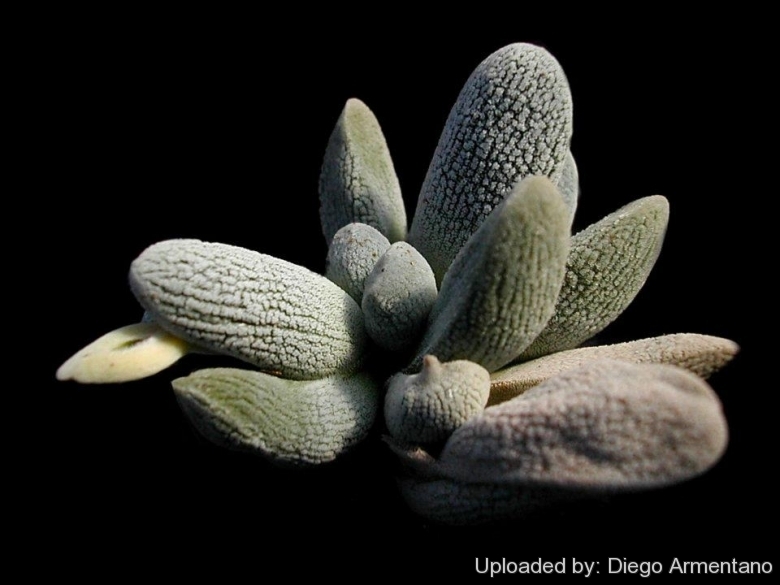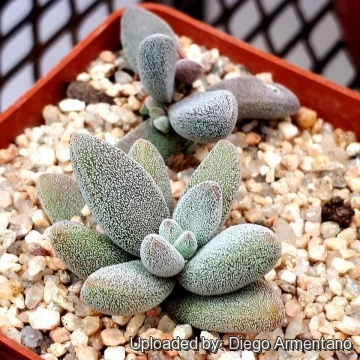




Your support is critical to our success.
Nova Acta Phys.-Med. Acad. Caes. Leop.-Carol. Nat. Cur. 6: 328 1778.
Family: CRASSULACEAE

Origin and Habitat: Republic of South Africa, Western Cape, mainly in the Little Karoo from near Montagu to Oudtshoorn but it has also been recorded from near Willowmore and Steytlerville. This plant is not considered to be rare in any way and not declining.
Habitat and ecology: Crassula tectaSN|32661]]SN|32661]] is an endemic to the winter-rainfall lowland plains of the Little Karoo. It grows on gravel flats, and on gentle lower slopes between exposed bedrock, usually shale, and sometimes, but not always, associated with white quartzite pebbles in the open, away from the protection of larger shrubs and in full sun. It is not common but occasionally occurs in relatively dense stands. Other interesting plants to be found there are Aloe variegata, Anacampseros papyraceaSN|11043]]SN|11043]], and Sarcocaulon patersoniiSN|27995]]SN|27995]]. The white papillae which cover the leaf surface give Crassula tectaSN|32661]]SN|32661]] a quartzitic stone-like appearance and render it virtually invisible to passing predators. The white papillae also act as a sunscreen reflecting most of the sun's harsh radiation, serving both to protect the leaf tissue from harmful UV rays but also to prevent the leaf from getting excessively hot, much like some cacti which are covered in white wool-like hairs, but also makes it somewhat unpalatable to animals. The life span would be in the region of 3–7 years, perhaps longer if conditions are favourable.
Synonyms:
- Crassula tecta Thunb.
- Purgosea tecta (Thunb.) Don
Crassula tecta Thunb.
Nova Acta Phys.-Med. Acad. Caes. Leop.-Carol. Nat. Cur. 6: 328 1778.
Synonymy: 3
- Crassula tecta Thunb.
- Purgosea tecta (Thunb.) Don
- Crassula decipiens N.E.Br.
ENGLISH: Brush mesemb, Lizard Skin Crassula, Covered crassula
AFRIKAANS (Afrikaans): akkedisvel
Description: Crassula tectaSN|35242]]SN|32661]] is a small and attractive perennial species with obtuse, greyish-green, thick leaves 20-30 mm long densely covered with ash coloured papillae resembling the scales of a butterfly's wing. It is somewhat more succulent than other members of the genus Crassula. Growth is not very fast, but eventually low compact clumps up to 5 cm tall and 6 cm wide, are formed which are entirely different from any of the other crassulas. The inflorescence consists of a head of several, white flowers at the end of a peduncle about 10 cm tall. There are several different looking clones of C. tecta.
Derivation of specific name: The specific name comes from latin “tecta”, “house-tops” and refers to the way in which the leaves cover one another, much like overlapping tiles.
Blooming season: Crassula tectaSN|32661]]SN|32661]] is a winter grower and will usually flower in autumn to mid-winter (between April and June in habitat).
Stem: Scarcely any, very short, semi-succulent, usually single or sparingly branched, but at times much branched and usually swollen at base, axis to 5 mm thick, with old leaves not deciduous.
Roots: Fibrous, shortly branched adapted to growing in very shallow soils.
Leaves. Sub-radical in basal rosettes. Connate, opposite and stacked at right angles to the pair above and below, ovate to ovate-lanceolate, highly succulent, 10-25(-35) mm long, 3-10(-15) mm broad, lamina flattish, epidermis with short, hard, irregularly shaped papillae, broadened towards apex but often with recurved cilia towards base, grey-green or ash coloured, upper face flat to slightly concave near the base, lower face convex, tip rounded, rarely bluntly acute or obtuse. In the eastern end of its distribution the leaves are more flattened and are keeled along the edge and tip.
Inflorescences: Elongated globose thyrses. Scape erect filiform, to 30-10(-12) cm long, covered with rounded papillae. In the field the inflorescence is usually unbranched but under cultivation it often consists of up to 3 part-inflorescences, in which case plants may be similar to Crassula sericeaSN|32661]]SN|35242]].
Flowers: Several, minute, white, 5-petalled and sessile. Sepals broadly triangular, 1,5-2 mm long, with rounded often obtuse apices, with recurved hairs and marginal cilia, fleshy, grey-green. Corolla white or cream to 5 mm long, tubular. Corolla lobes fused at the base, oblong-oblanceolate, 3-4 mm long, white to cream, tips recurved with indistinct dorsal appendage. Anthers yellow.
Fruits: Tiny fruits consist usually of 5 more or less separate parts (follicles) which after a month or so after flowering dry to release the minute dust-like seeds which are dispersed by wind and water.
Bibliography: Major references and further lectures
1) Tölken, H. R. “Crassulaceae. Flora of Southern Africa.” Vol. 14. Botanical Research Institute. 1985
2) Urs Eggli “Illustrated Handbook of Succulent Plants: Crassulaceae” Springer Science & Business Media, 06 December 2012
3) Dr J.P. Roux “Flora of South Africa”, 2003
4) Doreen Court “Succulent Flora of Southern Africa” CRC Press, 01 June 2000
5) John Wilkes “Encyclopaedia Londinensis”, Volume 5 1810
6) Thomas Green “The Universal Herbal: Or, Botanical, Medical, and Agricultural Dictionary. Containing an Account of All the Known Plants in the World, Arranged According to the Linnean System ... With the Best Methods of Propogation, and the Most Recent Agricultural Improvements” Printed at the Caxton Press by H. Fisher, 1820
7) Adam Harrower Kirstenbosch National Botanical Garden June 2013 “Crassula tecta Thunb.” in: Plantzafrica <http://www.plantzafrica.com/plantcd/crassulatecta.htm> Web. 02 March 2016.
8) Rowley, G. “Crassula. A grower's guide”. Cactus & Co. libri. 2003.
9) Vlok, J. and Schutte-Vlok, A.L. “Plants of the Klein Karoo”. Umdaus Press, Hatfield. 2010
10) Manyama, P.A. & Kamundi, D.A. 2006. Crassula tecta Thunb. National Assessment: Red List of South African Plants version 2015.1. Accessed on 2016/03/02

Crassula tecta Photo by: Diego Armentano
The gallery now contains thousands of pictures, however it is possible to do even more. We are, of course, seeking photos of species not yet shown in the gallery but not only that, we are also looking for better pictures than those already present. Read More...
Cultivation and Propagation: Crassula tectaSN|32661]]SN|32661]] is a diminutive and attractive grey-leaved succulent that is easy to grow and makes a great pot plant. It requires a free draining compost and good light to keep the plants compact and encourage leaf colour and flowering.
Water requirements: Extreme care is needed when watering these plants, remember not to over-water in the Summer when they're taking their rest. In cultivation they are spring and autumn grower (summer dormant). When there is too much water available in combination with too less light, the leaves won't form dense rosettes anymore and you will see a piece of stem between the leaves which will make the sight less pretty. Reduce watering during winter month , fairly drought tolerant elsewhere. The white papillose leaf coatings of the plants in our collection sometime is not so intense as those of the plants in their natural habitat but the difference in coating is thought due to the higher humidity and less intense sunlight of our climate.
Pest and diseases: Crassulas are sensitive to mealybugs.
Propagation: Seeds of stem cuttings.
| Your Actions | |
|---|---|
| Back to Crassula index | |
| Back to Crassulaceae index | |
 |
Back to Succulents Encyclopedia index |
Privacy stantement - Terms and conditions - How to cite - About us - Feedback - Donate




